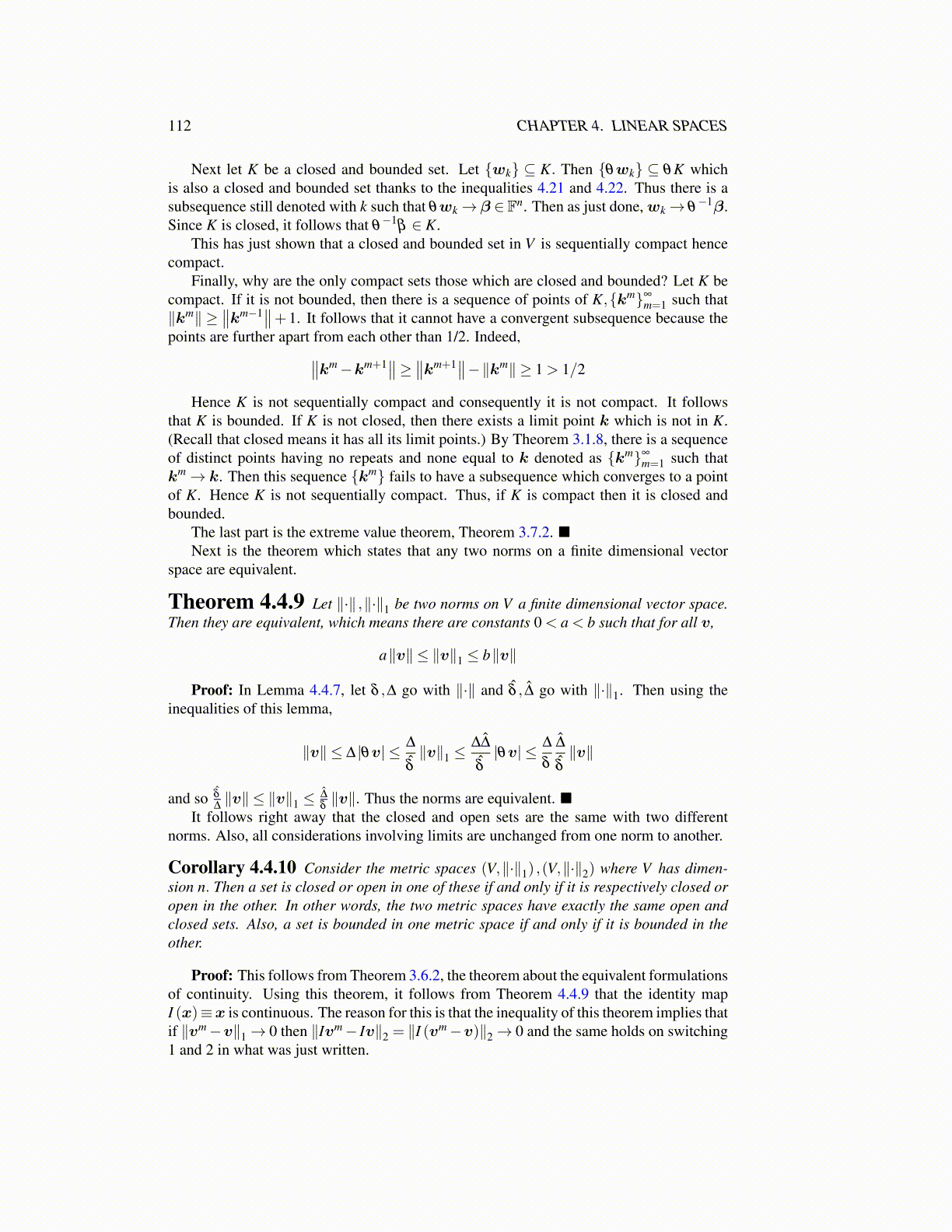
112 CHAPTER 4. LINEAR SPACES
Next let K be a closed and bounded set. Let {wk} ⊆ K. Then {θwk} ⊆ θK whichis also a closed and bounded set thanks to the inequalities 4.21 and 4.22. Thus there is asubsequence still denoted with k such that θwk→ β ∈ Fn. Then as just done,wk→ θ
−1β.Since K is closed, it follows that θ
−1β ∈ K.
This has just shown that a closed and bounded set in V is sequentially compact hencecompact.
Finally, why are the only compact sets those which are closed and bounded? Let K becompact. If it is not bounded, then there is a sequence of points of K,{km}∞
m=1 such that∥km∥ ≥
∥∥km−1∥∥+1. It follows that it cannot have a convergent subsequence because thepoints are further apart from each other than 1/2. Indeed,∥∥km−km+1∥∥≥ ∥∥km+1∥∥−∥km∥ ≥ 1 > 1/2
Hence K is not sequentially compact and consequently it is not compact. It followsthat K is bounded. If K is not closed, then there exists a limit point k which is not in K.(Recall that closed means it has all its limit points.) By Theorem 3.1.8, there is a sequenceof distinct points having no repeats and none equal to k denoted as {km}∞
m=1 such thatkm→ k. Then this sequence {km} fails to have a subsequence which converges to a pointof K. Hence K is not sequentially compact. Thus, if K is compact then it is closed andbounded.
The last part is the extreme value theorem, Theorem 3.7.2. ■Next is the theorem which states that any two norms on a finite dimensional vector
space are equivalent.
Theorem 4.4.9 Let ∥·∥ ,∥·∥1 be two norms on V a finite dimensional vector space.Then they are equivalent, which means there are constants 0 < a < b such that for all v,
a∥v∥ ≤ ∥v∥1 ≤ b∥v∥
Proof: In Lemma 4.4.7, let δ ,∆ go with ∥·∥ and δ̂ , ∆̂ go with ∥·∥1. Then using theinequalities of this lemma,
∥v∥ ≤ ∆ |θv| ≤ ∆
δ̂∥v∥1 ≤
∆∆̂
δ̂|θv| ≤ ∆
δ
∆̂
δ̂∥v∥
and so δ̂
∆∥v∥ ≤ ∥v∥1 ≤ ∆̂
δ∥v∥. Thus the norms are equivalent. ■
It follows right away that the closed and open sets are the same with two differentnorms. Also, all considerations involving limits are unchanged from one norm to another.
Corollary 4.4.10 Consider the metric spaces (V,∥·∥1) ,(V,∥·∥2) where V has dimen-sion n. Then a set is closed or open in one of these if and only if it is respectively closed oropen in the other. In other words, the two metric spaces have exactly the same open andclosed sets. Also, a set is bounded in one metric space if and only if it is bounded in theother.
Proof: This follows from Theorem 3.6.2, the theorem about the equivalent formulationsof continuity. Using this theorem, it follows from Theorem 4.4.9 that the identity mapI (x)≡x is continuous. The reason for this is that the inequality of this theorem implies thatif ∥vm−v∥1→ 0 then ∥Ivm− Iv∥2 = ∥I (vm−v)∥2→ 0 and the same holds on switching1 and 2 in what was just written.